The myth and folklore of ancient cultures speak of a vast cycle of time with alternating dark and golden ages; Plato called it the Great Year. Most of us were taught that this cycle was just a myth and the golden age, just a fairytale.
Giorgio de Santillana, former professor of the history of science at the Massachusetts Institute of Technology (MIT), USA, tells us this idea of a cycle went far beyond Greece and India. In their landmark work, Hamlet’s Mill, de Santillana and co-author Hertha von Dechend show that the myth and folklore of more than thirty ancient cultures mention a cycle of time with long periods of enlightenment broken by dark ages of ignorance. Moreover, they show that it seems to be connected to or driven by a known astronomical phenomenon, the precession of the equinox.
This is where modern science may now be giving us some startling new evidence.
We all know the two celestial motions that have a profound effect on life and consciousness. Earth’s rotation on its axis causes humans to move from a waking state to a sleep state and back again every twenty-four hours . Our bodies have adapted to Earth’s rotation so well that it produces these regular changes in consciousness without our even thinking the process remarkable.
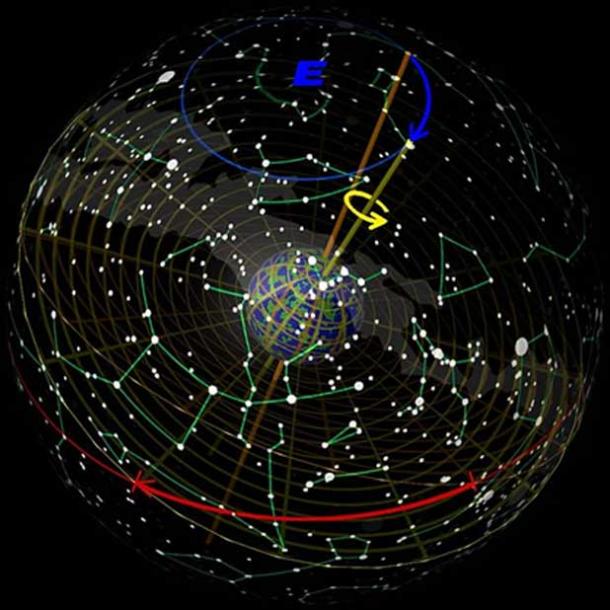
Precession of the equinoxes as seen from ‘outside’ the celestial dome. (Tau’olunga /CC BY-SA 2.5 )
The second Copernican motion , the earth revolving around the sun, has an equally significant effect, prompting trillions of life forms to spring out of the ground, to bloom, fruit, and then decay, while billions of other species hibernate, spawn, or migrate en masse. Our visible world literally springs to life, completely changes its color and stride, and then reverses with every waxing and waning of the second celestial motion. Again we are so used to it we hardly think it noteworthy.
The third celestial motion, libration, or the precession of the equinox, is less understood than the first two, but if we are to believe ancient cultures, its effect is equally transformative. What disguises the impact of this motion is its timescale. Like the mayfly, which lives but one day a year and knows nothing of the seasons, the human being has an average life span that comprises only 1/360th of the roughly 24,000-year precessional cycle. And just as the mayfly born on an overcast, windless day has no idea that there is anything as splendid as sunshine or a breeze, so do we, born in an era of materialistic rationality, have little awareness of a golden age or higher states of consciousness – though that is the consistent ancestral message.
As Giorgio and Hertha point out, the idea of a great cycle linked to the slow precession of the equinox was common to numerous cultures before the Christian era, but then lost. Now an increasing body of astronomical and archaeological evidence suggests the cycle may have a basis in fact. More importantly, understanding its ebb and flow and the character of each epoch provides insight into civilization’s future.
So far the Ancients are right on; there does seem to be evidence of a lost high age in Egypt , Mesopotamia, Ancient India , etc. long before the Dark Ages. Then we sunk into a period where even Greece and the great Roman Empire collapsed, with famine, plague and brutal inquisition as a rule. And finally, a renaissance (rebirth) of scientific knowledge helping us to emerge from the depths of the dark ages. So what drives these changes and what can we expect in the future? Understanding the cause of precession is key.
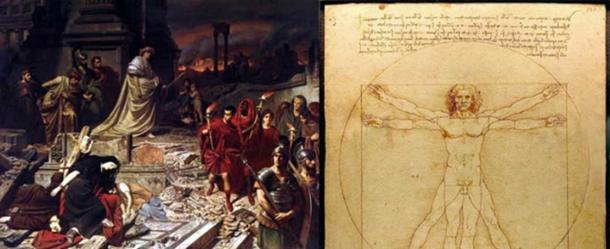
Cycles of rising and falling: The burning of Rome, and the rebirth of knowledge. (Public Domain)
Heavenly Observations
The observation of Earth’s three motions is quite simple.
In the first, rotation, we see the sun rise in the east and set in the west every twenty-four hours. And if we were to look at the stars just once a day, we would see a similar pattern over a year: the stars rise in the east and set in the west. The twelve constellations of the zodiac — the ancient markers of time that lie along the ecliptic, the sun’s path — pass overhead at the rate of about one per month and return to the starting point of our celestial observation at the end of the year. And if we looked just once a year, say on the autumnal equinox, we would notice the stars move retrograde (opposite to the first two motions) at the rate of about one degree every seventy years.
At this pace, the equinox falls in a different constellation approximately once every 2,000 years, taking about 24,000 years to complete its cycle through the twelve constellations. This is called precession (the backward motion) of the equinox relative to the fixed stars.
The standard theory of precession says it is principally the Moon’s gravity acting upon the oblate Earth that must be the cause of Earth’s changing orientation to distant space. However, this theory was developed before astronomers learned the solar system could move and has now been found by the International Astronomical Union to be “inconsistent with dynamical theory.” Ancient oriental astronomy teaches that an equinox slowly moving or “precessing” through the zodiac’s twelve constellations is simply due to the motion of the sun curving through space around another star, which changes our viewpoint of the stars from Earth.
To this date, astronomers have not yet discovered such a star so they dismiss the myth. But, just recently (January 2016), scientists at the California Institute of Technology (Caltech) in California, USA, have publicly stated they have found evidence of a large gravitational influence on one side of our solar system forcing the minor planets (like Pluto and Sedna) to fall into elongated, inclined patterns. Consequently, modern science is now looking for either a ninth planet or a star affecting our solar system.
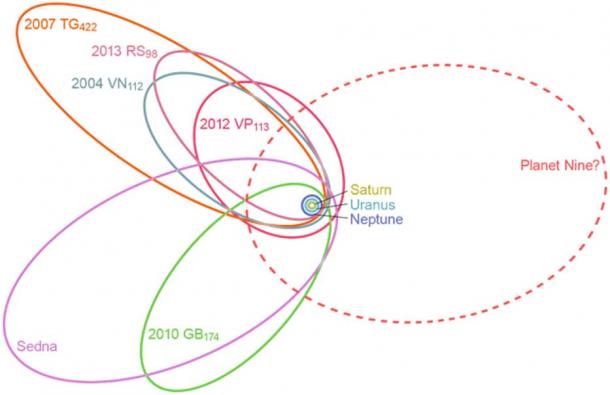
Orbital correlations among six distant trans-Neptunian objects led to the hypothesis of a Ninth Planet. ( CC0)
Beyond the technical considerations, a large mass would provide a logical reason why we might have a Great Year , to use Plato’s term, with alternating dark and golden ages. That is, if the solar system carrying the Earth actually moves in a huge ~24,000-year orbit around another mass, subjecting Earth to the electromagnetic (EM) spectrum of another star or EM source along the way, shaping the subtle electrical and magnetic fields through which we move, we could expect this to affect our magnetosphere, ionosphere, and very likely all life in a pattern commensurate with that orbit. So, just as Earth’s smaller diurnal and annual motions produce the cycles of day and night and the seasons of the year (both due to Earth’s changing position relative to the EM spectrum of the Sun), so might the larger celestial motion be expected to produce a cycle that affects life and consciousness on a grand scale.

Artist’s depiction of a mysterious Ninth Planet. (CC BY-SA 4.0)
A hypothesis for how consciousness might be affected by such a celestial cycle can be built on the work of Dr. Valerie Hunt, a former professor of physiology at the University of California, Los Angeles (UCLA). In a number of studies, she has found that changes in the ambient subtle electrical, EM and magnetic fields (which surround us all the time) can dramatically affect human cognition and performance . In short, consciousness appears to be affected by subtle fields of light, that may have long term effects barely understood.
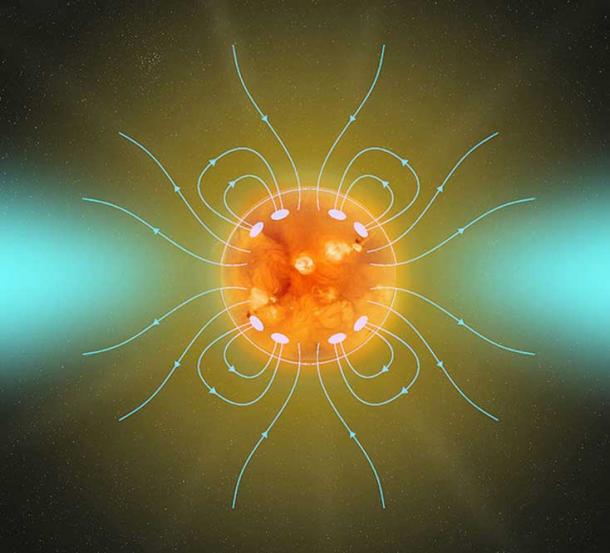
Illustration of the magnetic fields in the solar corona. ( CC BY-SA 3.0 )
Consistent with myth and folklore, the concept behind the Great Year or cyclical model of history is based on the Sun’s motion through space, subjecting Earth to waxing and waning stellar fields (all stars are huge generators of EM spectra) resulting in the legendary rise and fall of the ages over great epochs of time.
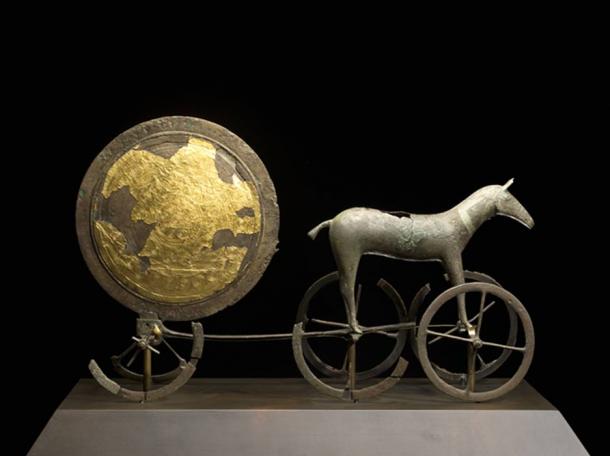
The Trundholm sun chariot (c. 1350 BC) pulled by a horse is a sculpture believed to be illustrating an important part of Nordic Bronze Age mythology. ( Nationalmuseet/CC BY-SA 3.0 )
Historical Perspectives on the Golden Age
Current theories of history generally ignore myth and folklore and do not consider any macro external influences on consciousness. For the most part, modern history theory teaches that consciousness (or history) moves in a linear pattern from the primitive to the modern, with few exceptions, and it includes the ideas that people were hunter-gatherers until about 5,000 years ago, tribes first banded together for protection from other warring parties, and written communication must precede large engineered structures or populous civilizations.
The problem with this widely accepted paradigm is that it is not consistent with the evolving interpretation of recently discovered ancient cultures and anomalous artifacts.
In the last hundred years, major discoveries have been made in Mesopotamia, the Indus Valley, South America, Turkey and many other regions that break the rules of history theory and push back the time of advanced human development. Specifically, they show that ancient peoples were, in many ways, far more proficient and civilized nearly five thousand years ago than they were during the more recent dark ages of just six hundred to a thousand years ago.
In Caral, an ancient complex of unknown origin on the west coast of Peru, we find six pyramids that are carbon dated to 2700 BC, a date contemporaneous with Egyptian pyramids and that rivals the time of the first major structures found in the so-called Cradle of Civilization in Mesopotamia. Caral is an ocean away from the Cradle. We find no evidence of writing or weaponry, two of the so-called necessities of civilization, but we do find beautiful musical instruments, astronomically aligned structures, and evidence of commerce with distant lands (fabrics, seeds and shells not indigenous to the area)— all signs of a prosperous culture.
Gobekli Tepe presents an even greater challenge to conventional accounts of history. Dated to at least 9000 BC, this site in Turkey contains dramatic architecture, including huge carved pillars. To find that something so large and complex existed long before the dates accepted for the invention of agriculture and pottery is an archaeological enigma. These sites defy the standard historical paradigm. And what is stranger still is that so many of these civilizations seemed to decline en masse.
In ancient Mesopotamia, Pakistan, Jiroft, and adjacent lands, we find knowledge of astronomy, geometry, advanced building techniques, sophisticated plumbing and water systems, incredible art, dyes and fabrics, surgery, medicine, and many other refinements of a civilized culture which seem to have emerged from nowhere and were completely lost over the next few thousand years.

Archaeological site of Göbekli Tepe in Turkey. ( CC BY-SA 3.0 )
By the time of the worldwide dark ages, every one of these civilizations, including the big ones in Egypt and the Indus Valley, had largely turned to dust or nomadic ways of life. Near the depths of the cyclic downturn, there were ruins and little else, while the local populace knew nothing of the builders except through legend. In some areas where larger populations still remained, such as parts of Europe, poverty, plague, and disease were often rampant, and the ability to read, write, or duplicate any of the earlier engineering or scientific feats had essentially disappeared. What happened?
While records of this period remain spotty, the archaeological evidence indicates that consciousness, reflected as human ingenuity and capability, was greatly diminished. Humanity seemed to have lost the ability to do the things it used to do. Interestingly, this is just what many ancient cultures predicted.
Stefan Maul, the world’s foremost Assyrianologist, shed light on this phenomenon in his 1997 Stanford Presidential Lectures series. He tells us that the Akkadians knew they lived in a declining era. They revered the past as a higher time and tried to hang on to it, but at the same time, they predicted and lamented the dark ages that would follow. Maul’s etymological studies of cuneiform tablets show the ancient words for “past” have now become our words for “future” and the ancient words for “future” have become our words for “past.” It is almost as if humanity orients its motion through time depending on whether it is going toward or away from a golden age.
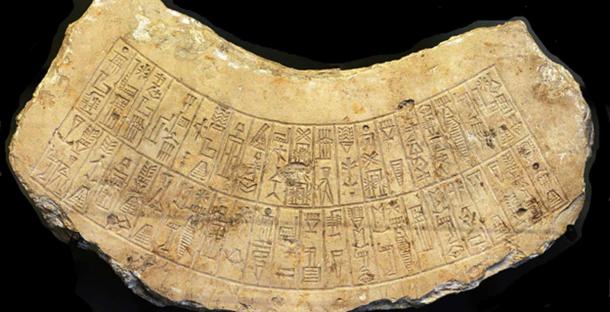
Akkadian inscription found at the city of Marad in Iraq, ca. 2260 BC. ( CC BY-SA 2.0 FR )
This principle of waxing and waning epochs is depicted in numerous bas-reliefs found in ancient Mithraic “mystery school” temples. The famed Tauroctony, or bull-slaying scene, is usually surrounded by two boys, Cautes and Cautopetes. One holds a torch up on the ascending side of the zodiac, indicating a time of increasing light, and the other holds a torch down on the descending side of the zodiac, indicating a time of darkness. These are further broken into ages, which the Greeks deemed, “Iron, Bronze, Silver and Gold”, a simple way to describe the epochs of the Great Year.
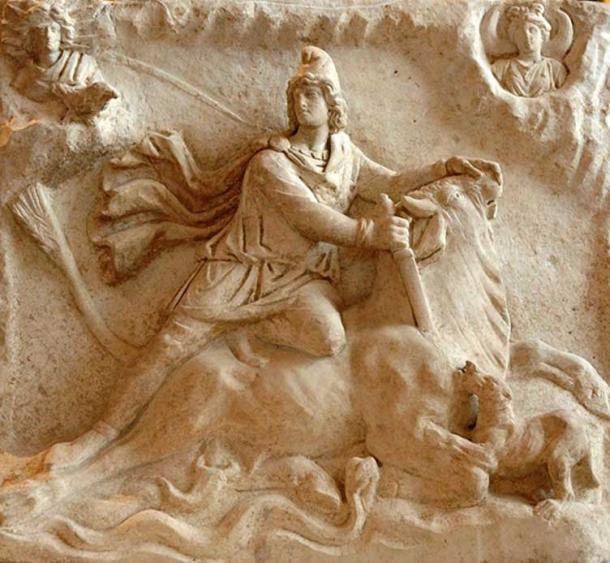
Tauroctony scene on a Roman bas-relief. 2nd or 3rd century. ( Public Domain )
Understanding that consciousness may indeed rise and fall with the motions of the heavens gives meaning to ancient myth and folklore and puts anomalous cultures and artifacts, such as the Antikythera device and the Babylon battery , into a historical context that makes sense. For example, the battery was developed at least 2,000 years ago, lost in the dark ages, then reinvented by Volta in the post renaissance period. The same thing goes for prosthetic devices, brain surgery, and knowledge of a heliocentric system and advanced engineering, etc. They were discovered, lost, then rediscovered.
It also speaks to why so many ancient cultures appear to have been fascinated with the stars and provides us with a workable paradigm in which to understand history. It could also help us identify the forces that propelled the Renaissance and that may be accelerating consciousness in our current era. Myth and folklore, the scientific language of yore, provide a deeper look at consciousness throughout the ages.
Astronomical Race
The recent news out of Caltech is prompting astronomers and astrophysicists around the world to look for something big out there . The race is on. It just may be that they finally give us a reason for the cycle of the ages.
Top Image: Golden Age. Source: Juan Carlos Barquet
Updated on November 18, 2020.
Walter Cruttenden is the Director of the Binary Research Institute, an archaeoastronomy think tank in California, USA. He is the author of Lost Star of Myth and Time , The Great Year Adventures , and the award winning documentary, The Great Year , narrated by James Earl Jones.
 RSS Feed
RSS Feed















 November 19th, 2020
November 19th, 2020  Awake Goy
Awake Goy  Posted in
Posted in  Tags:
Tags: 













